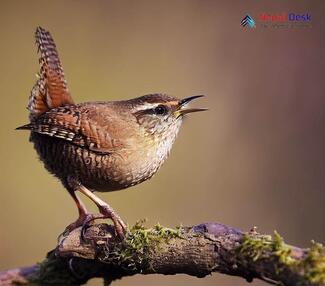The Eurasian Wren (Troglodytes troglodytes) is one of the captivating creatures that finds its home among the lush forests and vibrant ecological hotspots. It is a small insectivorous bird and the only member of the wren family Troglodytidae found in Eurasia and Africa (Maghreb). It was once lumped with Troglodytes hiemalis of eastern North America and Troglodytes pacificus of western North America as the winter wren. One interesting fact is that the taxonomy of the genus Troglodytes is currently unresolved, as recent molecular studies have suggested that Cistothorus spp. and Thryorchilus spp. are within the clade currently defined by Troglodytes.
Let us look at the various facts about this charming creature:
A Snapshot of the Eurasian Wren
Don't let its small size fool you – the Eurasian Wren is a powerhouse of charisma and mysterious allure. With a body length of just 9-10 cm and weighing around 8-13 grams, this tiny bird boasts an incredible vocal display that echoes throughout its habitat. The Eurasian Wren can be identified by its brown plumage filled with intricate patterns, short rounded wings, and an iconic stubby tail held proudly upright.
Habitat and Distribution in Nepal
The diverse landscapes of Nepal offer a perfect home for this unassuming songbird. From dense forests to sparse woodlands, the Eurasian Wren can be found at elevations ranging between 1,250 meters and 3,660 meters. Some prime locations to spot them include Shivapuri Nagarjun National Park near Kathmandu, Annapurna Conservation Area, and Langtang National Park.
Behavior and Feeding Habits
The Eurasian Wren's diet mainly consists of insects and spiders located in their natural habitat. With their innate curiosity and agility, these birds can frequently be seen hopping through foliage and skillfully flicking leaves to uncover their next meal. They are tenacious hunters despite their petite size and are blessed with acute hearing to locate their prey. Their inquisitive demeanor offers a fascinating experience for bird lovers to enjoy.
Breeding Season Delights
The breeding season for the Eurasian Wren in Nepal spans from April to July. These captivating birds create spherical nests in tree cavities, branches, and other concealed spots, making them a wonderful find for keen-eyed birdwatchers. During this period, their displays of courtship songs are particularly enchanting and highlight their astonishing vocal prowess.
Conservation Concerns and Efforts
Although the Eurasian Wren is not considered an endangered species, it still faces threats from habitat destruction and climate change. It's vital to recognize the importance of protecting Nepal's diverse ecosystems to ensure these charming birds continue to thrive. By supporting local conservation efforts and promoting sustainable tourism in Nepal, the spectacular song of the Eurasian Wren will resonate through the country's forests for generations to come.
In conclusion, the Eurasian Wren is undoubtedly one of Nepal's captivating avian gems. Their enchanting melodies and intriguing habits make them a sought-after experience for birdwatchers and nature enthusiasts alike. As you explore the breathtaking landscapes of Nepal, keep an ear out for the distinctive call of the Eurasian Wren – a blissful reminder of nature's symphony that awaits your discovery.




